The Robots

Many continuously dividing, rounded cells, leaping symbols, colorful capsules, and sweet gummies float in real space, overlapping and devouring each other. These seemingly familiar, colorful "substances" appear as precisely and flawlessly synthesized as computer-generated imagery, yet they possess a sense of heaviness, volume, and warmth. This was my first impression upon seeing Zi Xu’s works in pictures—I initially assumed they were sculptures. However, when I encountered them in reality, I realized that these works were a collaboration between him and mechanical processes, a deliberate visual deception. What appears to be three-dimensional material is, in fact, a two-dimensional piece existing in a flat space.

Despite their lack of physical depth, I hesitate to call them mere images. Instead, I see these deceptive "three-dimensional symbols" as magnified glitches in everyday life. The term "bug" carries multiple meanings: originally referring to an insect, it also denotes system loopholes, errors, and even listening devices. I was reminded of a photo Zi Xu posted on social media: a neatly paved brick road in smooth, evenly distributed colors, disrupted by a glaring fluorescent pink circle of graffiti. The circle was so strikingly out of place that it appeared to be floating above the surface, breaking the normal rules of perspective. This sensation is familiar in daily life: if you stare at a very familiar word for too long, it gradually begins to lose its meaning. In psychology, this phenomenon is called Semantic Satiation.
In images, Zi Xu’s works seem almost devoid of any human touch—perfectly smooth contours, near-flawless color gradients, and an almost unnatural precision. However, upon closer inspection, the warmth they convey assured me that these AI-like objects were, in fact, the result of repetitive human labor. Machines can achieve precision, but their precision lacks warmth—it is merely a matter of data accuracy. Zi Xu, through manual labor, injects warmth into mechanical processes. I have always believed that the confrontation between human craftsmanship and mechanized production is a defining characteristic of modern society. To validate this idea, I observed his working process.
What fascinated me most in this confrontation was the shifting of identities between human and machine. Zi Xu’s workspace embodies the most primitive mode of labor—a process akin to grinding tofu, where the same standard force is applied repeatedly. In this process, he attempts to transform himself into a "machine" to create textured, uneven surfaces. Meanwhile, the machines that assist him take on human-like qualities, adapting to irregular operations. In other words, the mechanical process is forced to function under intentional errors—for example, a printing process that must operate on an uneven surface, introducing elements of randomness and deviation.
Deviation first arises from human limitations—we cannot achieve absolute precision. However, humans are inherently adaptable, capable of compensating for certain errors through improvisation. Machines, on the other hand, adhere to absolute accuracy, as their parameters are pre-defined numerical values. Consequently, mechanical errors tend to be irreversible. Within this coexistence, confrontation, and even identity exchange between human and machine, error becomes an unavoidable theme. Both sides push forward under their respective notions of "accuracy." Zi Xu’s works emerge as the outcome of this dual error, yet this result is ultimately unpredictable.
This exhibition could be seen as Zi Xu’s boomerang projection of reality’s bugs. Interestingly, as I watched Zi Xu at work, my mind kept flashing back to Kraftwerk’s 1978 single, "The Robots". The lyrics explore the role of robots as subservient workers to humans. The Russian phrase "Я твой слуга / Я твойработник" (Ya tvoy sluga / Ya tvoy rabotnik, "I am your servant / I am your worker") is uttered in a deep voice during the intro and interludes, while the main lyrics ("We are charging our batteries, and now we’re full of energy…") are vocoded rather than sung in a human voice. In this confrontation between human and machine, the identities of both have become so displaced that it is difficult to distinguish who is the robot and who is the human.

WOODSTOCK YUNG
Feb 2025

























































